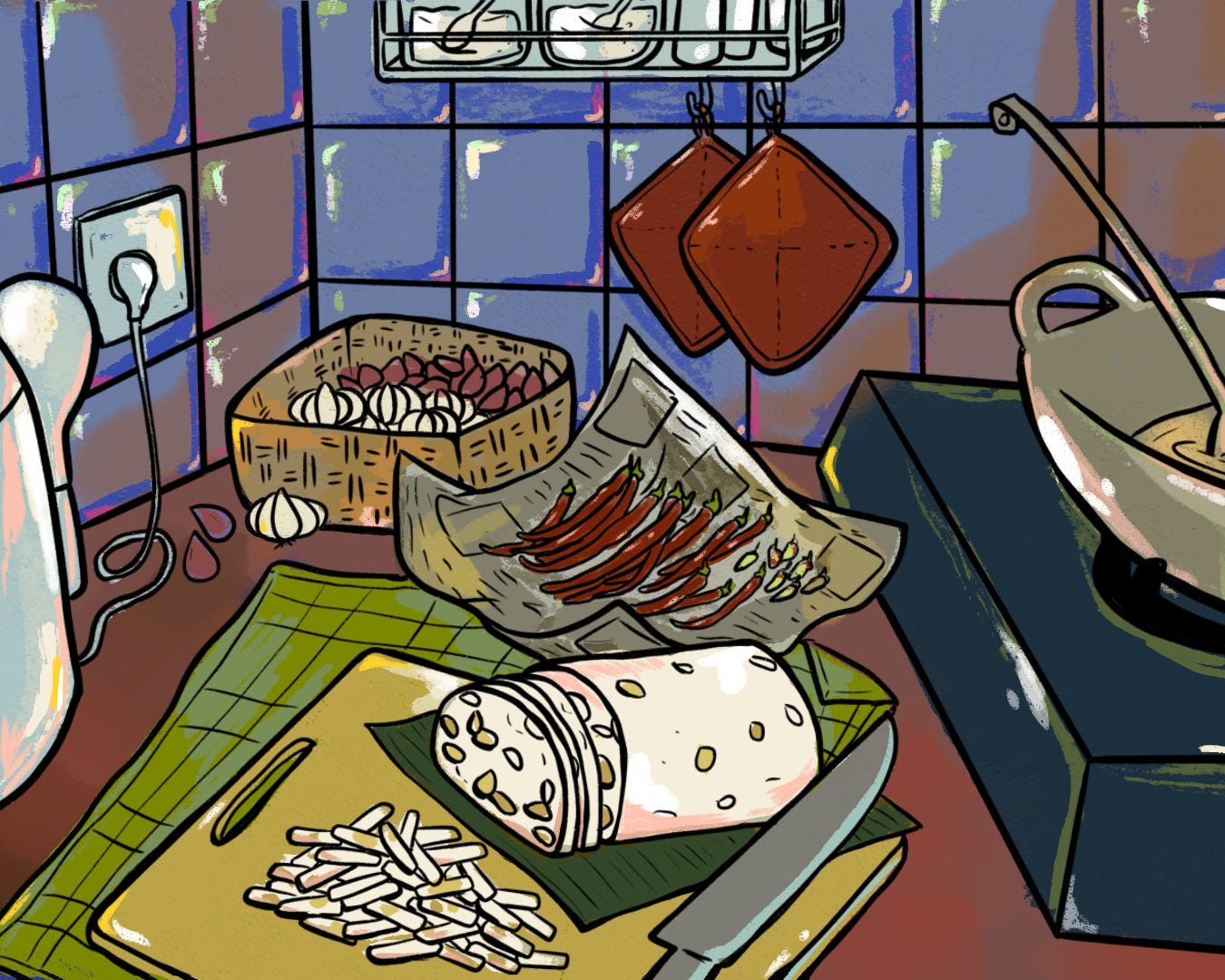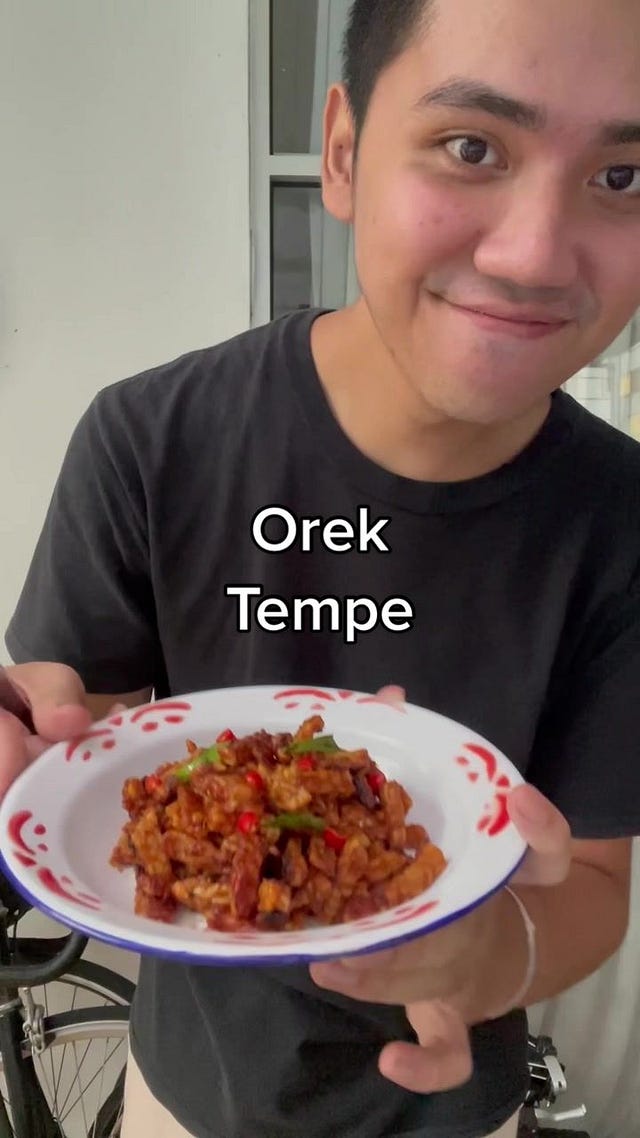How to Love Tempe, Even When America's Involved
We, as Indonesians, love our soybeans too much. But is it really ours if they don't come from here?
Halo and Happy Monday!
Time really flies when it’s nearing the end of the year huh? These past two weeks have been crazy. Mariah Carey announced that it’s time, Jakarta just got hit by a storm, and I made it to national TV (more on this later).
Today’s newsletter covers a topic that is very dear and near to me - tempe. Just like how we usually have an entire row of stalls dedicated to tempe in our local market, I feel like I should also have one entire post just for it. If you don’t know what tempe is, you’re in for a treat to learn all about it today! You will learn:
😋 What tempe is, it’s origin, and how obsessed Indonesians are with it.
🚩 The ugly truth behind Indonesia’s soybeans industry (spoiler: local production is declining, and we import 90% of our soybeans).
🤟 Things that were done to mitigate this issue and things we can do to contribute, which involves cooking!
TW: Bar charts, pie charts, and other statistics. Guess I’m just geeky like that! 😜
If there is one thing that I am very proud of about Indonesian food, it would have to be tempe. I could talk about it all day. On how tasty it is, how nutritionally packed, how versatile, and how it’s now being called a superfood and appeared in almost all of the indie and hipster food places in the Western world. I think that’s one of the biggest achievements that your local food can get - to be gentrified.
Tempe is such a brilliant invention. In a nutshell, it’s fermented soybeans that turned into a block - made from thousands of strands of Rhizopus oligosporus fungi. It was originally discovered in Klaten, Jawa Tengah and first documented in literature in the 1600s. It’s old. It’s ancient. It’s original. One study even argues that it is the only traditional soy-based food that does not originate from China.
Tempe is a good source of plant-based protein that, very rarely, is loved not only by the vegan community. Everybody loves tempe.
Think about other plant-based meat alternatives. Like those soya chunks that taste like wet cardboard or that plant-based burger patties that taste like preservatives and everything else but meat. These alternative products not only promise us the taste, aroma, and texture of meat but also capitalize on the promise of enjoying meat without the associated harm.
Tempe on the other hand, is just tempe. In fact, it is its own thing that it deserves not to be typed in italics. Tempe is not a meat substitute or a trendy item like how the Western world sees it. It’s a beloved food that can be found almost everywhere - from your local warung (a small, usually by-the-road eatery), a hip health-conscious cafe, to a five-star hotel restaurant.
To show you how much we love our soy, let me take you first on a trip to Pasar Tebet, a local market in the south of Jakarta.
The first thing that you’ll see the moment you go downstairs from the entrance is definitely the dried bean stalls. I wanted to say it’s an entrance gate but honestly, there were no gates at all. It’s just stairs that lead you to the lower ground where you’ll find your regular white soybeans, red beans, and even mung beans. They usually are presented in uncovered sacks, sometimes in a shape that resembles a mountain, but other times you would also find them pre-packaged.
Just a few steps down the aisle is the wet area where all the fresh produce sellers hang. There’s an area for just poultry and beef, another area for seafood, and in between them, you’ll come across a stall specializing in fermented soy products. Yes, one whole stall, juust for fermented soy products.
I don’t think we have a proper name for these sellers, but I just call them tukang tahu tempe - which loosely translates to “tahu (tofu) and tempe seller” because… that’s literally what they sell. Tahu, tempe, and sometimes oncom, a fermented product from excess soybean pulps from tofu production. It’s either we’re just that crafty, or we’re so obsessed with soybeans, we’re not letting a single part of them be wasted.
To end the trip, you can take the stairs back to the ground level where you’ll be greeted with small grocery stalls, selling dried goods including soy sauce and kecap manis (sweet soy sauce). Also, don’t forget to take away some fresh soymilks on your way out.
My favorite way to cook tempe is to turn them into tempe orek - saute them with a drizzle of coconut oil, thinly sliced garlic, shallot, chilies, and you guessed it, kecap manis. It’s literally just fermented soybeans dressed in a sweet soy sauce.
(Note: Sorry for not having English subtitles below but I’m sure you’ll get the idea of what I’m cooking! You’ll see more English subtitles in my recent videos).
So yeah, tempe is pretty much The It Girl. Even though she’s often time overlooked, she’s still original and unique, and she’s serving range! She doesn’t need to pretend to be something else that she’s not, and that’s giving so much Mia Goth in Pearl (2022). She’s giving “NAUR I’M A STAR”.
Unfortunately, just like Pearl, the soybean industry in Indonesia is a walking red flag. So unless your favorite color is red, it’s not a good look for us.
Indonesians consume a lot of soybeans - 3.2 million tons of soybeans per year on average in the past five years to be exact. To put it in a simple, on-top-off-my-head math that doesn’t consider other factors except population number, that will be 11kg of soybeans per person per year. You’re more than welcome to do a more accurate calculation, but I’m not applying to Deloitte here.
In other words, we need to grow a shit ton of soybeans. But no problem! That should be easy right? We have a lot of farmers here in Indonesia, and everyone needs soybeans! So that’s a no-brainer for us to… grow… soybea-

Umm, yeah no, I take that back. It seems that the farmers are struggling?
The soybean’s production trends from 2016 to 2020 have been fluctuating, but showing declining trends. Moreover, in 2022, we failed to meet the target of producing 710,000 tons of soybeans. We didn’t even meet half of the target (CNBC Indonesia, 2022).
But wait, the numbers are not numbering.
If Indonesians eat 3.2 million tons of soybeans a year and are only able to produce 710,000 tons of them in 2022. Where’s the rest of the soybeans coming from?


Ahh OK. Imported soybeans.
It’s pretty concerning, scary even for me to see that 90% of all the soybeans consumed in Indonesia are imported; mostly (like 90% of the imported soybeans) from the United States. That means you’re more likely to eat tempe that is made with American soybeans rather than a local one. Four out of five of your tempes are American.
Americans are good at influencing the whole world with their pop culture. But soybeans? Of all things? RAHHHHH 🦅🏈🇺🇸🗽
But before the Americans come for me to say that it’s not their fault that Indonesia imports soybeans from them, let me be clear: I agree. It’s not you, USA, it’s us.
Importing goods is not inherently bad. Sometimes it is important just for the sake of fulfilling the necessities. Because if we don’t have enough soybeans, how are we going to get our tempe? However, importing does become problematic when it starts to create excessive dependency that ultimately, will lead to a decline in local soybean production - which unfortunately is already happening.
Here’s a story from Tata Marongge, a local soybean farmer from Sumedang, Jawa Barat.
Quoting from what he told Republika, growing soybeans is challenging nowadays as the low selling price for local soybeans (Rp5,000 per kilogram) will usually only cover the operational cost without giving him any profits. On top of that, he also mentioned that tahu and tempe producers have a high standard nowadays. He said that producers are now looking for soybeans with bigger seeds and lower pulp content - something that the local soybeans can’t compete with.
Moreover, the fluctuating and really small price gaps between local and imported soybeans made a lot of farmers shift to grow other more profitable crops like corn and tobacco.

TLDR, here is what’s happening so far:
Indonesians eat a lot of soybeans.
But farmers don’t really want to grow them. They like corn and tobacco more. They say soybeans are not it - because of the:
High operational cost
Low selling price = low profit
We have no soybeans to make tempe and kecap manis. So we import them from the US. Like, almost 90% of what we need.
This is baaad. If this continues, we will be a very unsustainable soy society that runs and depends on imported resources. Isn’t it ironic? We love soy, we create shits and innovate things out of them, and it’s literally a staple product in our households, but when it comes to growing it ourselves we’re like, “Hmm corn”.
I guess what they said it’s true, we fall in love with things that we can’t have.
While several farmer’s aids have been done by the local governments, it can still feel stressful to read about how Indonesian farmers, that come from an agricultural country are still struggling. So let’s end it by focusing on what we as an individual can do to help support and advocate for this issue. As an Indonesian, Indonesian diaspora, and other global citizens, you can:
Support local movements that advocate this issue such as Indonesia Tempe Movement.
Support brands that are prioritizing local soy and ingredients. Shameless promo alert: My own small business specifically uses non-GMO local tempe and prioritizes local ingredients for its product. You can check Tamanan here.
Build the mindset and share with the world that tempe, tahu, and other soy-based products are as good as their animal-based contender.
Cook and have fun with it! Here are some of my favorite ways to cook tempe: Tempe Orek, Tempe Katsu, and Deep-fried Tempe.
How does this newsletter make you feel? Do you know other food-related issues that are happening in your country or local area? Let me know in the comments below!
Other contents that I made recently:
📖 Read my latest essay on managing food expectations: here.
☝️ Video of me making my own tempe (Pt.1): here.
✌️ Video of me cooking my own tempe (Pt.2): here.
🍚 A recipe video of rice salad (yes, it’s a thing): here.
Life update: Being on a national TV was actually on my bingo card (hehe), but definitely not the 2023 one, especially not in my second language.
To celebrate World Vegan Day 2023, I was very honored to be invited to share my journey toward a plant-based diet and do live cooking (I cooked tempe, duh) at the 3-Hour News show at SEA Today. The good news, the whole show was done in English! You can watch through the links below:
If you like today’s newsletter, please like and share it with your friends! Comment down below your thoughts and let me know if you have any other topics you want me to discuss. Until then, I’ll see you in two weeks!
Follow me everywhere:
TikTok: @berusahavegan
Kepayang’s Instagram: @readkepayang
Instagram: @menggemaskan
LinkedIn: Chalafabia Haris
Work with me: readkepayang@gmail.com








this is similar to us but with rice :/